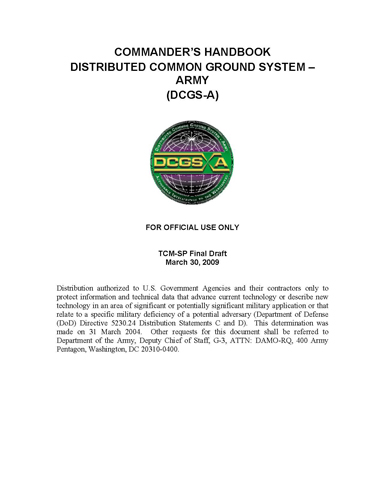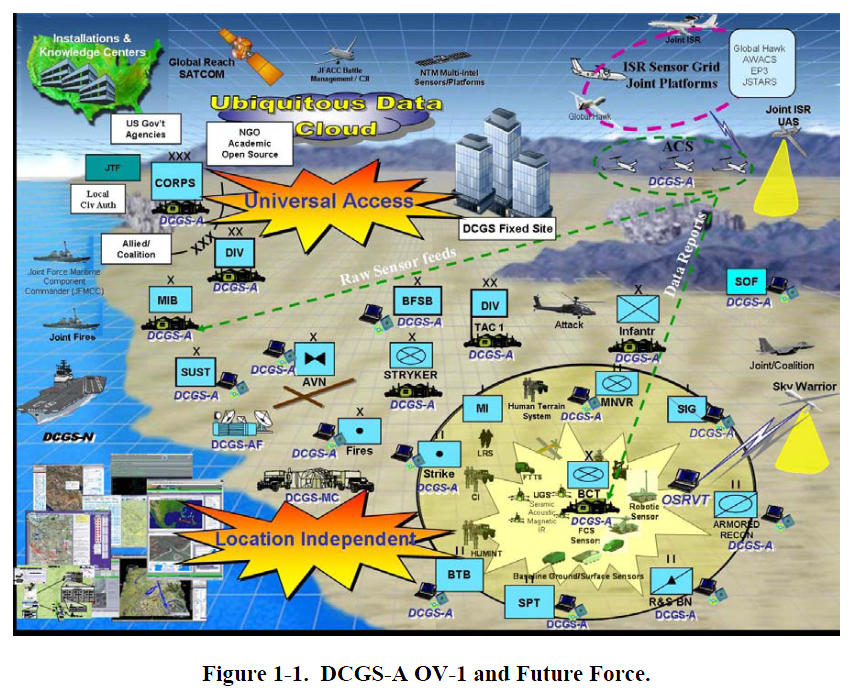TCM-SP Final Draft
- 18 pages
- For Official Use Only
- March 30, 2009
EXECUTIVE SUMMARY
Access to the Intelligence Enterprise is through the Distributed Common Ground System-Army (DCGS-A). This Commander’s Handbook is an overview of the capabilities DCGS-A is providing to the commander. It addresses the benefits of employment of DCGS-A as a whole, rather than any particular fielded version.
DCGS-A, as a component to the DoD Distributed Common Ground/Surface System Mission Area program, is greatly contributing to the Joint and combined Warfighter needs.
DCGS-A enables the Commander to fight in ways that exceed the historical limitations through the following three interrelated main ideas:
1.) Increased situational awareness reduces risk for the Commander when executing missions.
2.) A flattened network enables Commanders greater access to information historically only available to Corps and above echelons.
3.) Providing Commanders with unprecedented access to the Intelligence Enterprise affords the greatest impact at the lowest level.
The three core functionalities of DCGS-A are:
1.) It is the ISR component of Battle Command.
2.) It provides analysts a net enabled capability to exploit information with common analyst tools.
3.) It receives direct feeds from multiple sensors.
DCGS-A has three configurations, which enable Commanders to tailor the system and its components to fit their mission needs:
1.) Fixed configuration- Primarily it leverages the power and stability of sanctuary for the most complex processing and analytic tasks, and is currently available.
2.) Mobile configuration- Provides tactical, expeditionary, and deployable capabilities to Brigade Command Team (BCT) and other Commanders and is currently a quick reaction capability (QRC).
3.) Embedded software- On battle command systems (BCS) enables access to the intelligence enterprise down to the platform (e.g. Future Combat Systems (FCS)).
This handbook is a living document. Updates will follow as the DCGS-A system progresses. This will allow Commanders a concise reference guide to the capabilities provided to their units and its application to leverage DCGS-A against current and future adversaries.…
…
Chapter 2
FUNCTIONALITY
2-1. ISR COMPONENT OF BATTLE COMMAND
a. DCGS-A is the ISR component of the modular and future force BCS and the Army’s primary system for ISR tasking of sensors, processing of data, exploitation of data, and dissemination of intelligence (TPED) information. DCGS-A provides critical battle information about the threat, weather, and terrain at all echelons. DCGS-A will provide the capabilities necessary for Commanders to access information, task organic sensors, and synchronize non-organic sensor assets with their organic assets. These services will be shared by Commanders across an enterprise (provided by the Network-Centric Enterprise Services (NCES)) using the DCGS Integration Backbone (DIB) to enhance interoperability of ISR information.
b. DCGS-A will provide continuous acquisition and synthesis of data and information from Joint, Interagency, Intergovernmental, and Multi-national (JIIM) sources that will permit Commanders to have an updated and accurate picture of the operational environment. This will allow Commanders to maximize their combat power and enhance their ability to operate in an unpredictable and changing environment throughout the operational spectrum.
c. DCGS-A will provide critical accessibility to combat information as the ISR component of Battle Command. By providing a two-way information flow from the BCS to the intelligence enterprise, DCGS-A will enable the intelligence enterprise the accessibility to surveillance and reconnaissance obtained through non-military intelligence collections.
2-2. COMMON ANALYST TOOLS
a. Providing unrestricted access to intelligence information to the Brigade Commander has always been a challenging process. Historically, the ability to provide critical NRT intelligence took 30 military intelligence vehicles manned with over 100 Soldiers to produce the situational awareness and resided at the division level. The composition of a brigade could not handle such an increase in footprint. However, DCGS-A has reduced this footprint to approximately seven vehicles. By incorporating various programs of record (POR) into one system, this allows Commanders to equip the analyst, instead of manning the equipment. One of the ways this occurs is by reducing duplicate functionality and providing common analyst tools.
b. Formerly, analysts were required to have specialized training on specific operating systems to maximize the full effect of an operational intelligence community. The common tasks of analyzing, mapping, and disseminating finished products were accomplished in completely different ways. An example of this is the process it would take to provide actionable intelligence to the BCT. The Human Intelligence (HUMINT) collector would input his data into a HUMINT system. He would use his own mapping and analytical tools to produce a product. Analysts would attempt to pass the product through a different communication support system. Unfortunately, his products were not compatible with the All Source Analyst’s system and would often be unactionable or lost due to data incompatibility. Unless the All Source Analyst directly spoke to the HUMINT teams, this information was not included in the COP. For example, critical information about the pattern of life or social tendencies was not included in the actionable intelligence and would leave patrols or tactical HUMINT teams (THT) exposed.
c. DCGS-A provides common tools to assist in providing all analysts a greater understanding of each discipline and enables cross training. Common tools enhance analyst’s ability to share data and information and to collaborate on answering the Commander’s PIR. These tools support a central DCGS-A concept of teaming to solve problem sets vice depending on the current discipline-centric approach. This increases awareness within the operating cell and leads to more precise collection plans, and situational development.



